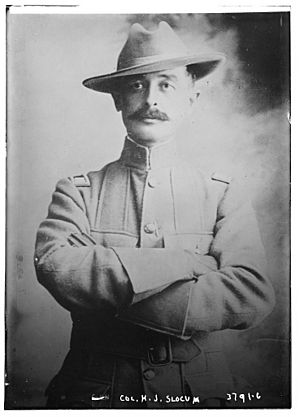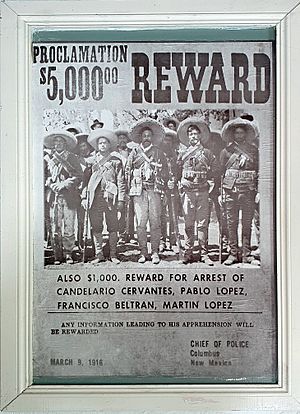Battle of Columbus (1916) facts for kids
Quick facts for kids Battle of Columbus |
|||||||
|---|---|---|---|---|---|---|---|
 Columbus, after the battle |
|||||||
|
|||||||
| Belligerents | |||||||
|
|
|||||||
| Commanders and leaders | |||||||
| Strength | |||||||
| 353 | 484 | ||||||
| Casualties and losses | |||||||
| 8 killed and 15 wounded | 67 killed and many more wounded 7 captured |
||||||
| 10 civilians killed | |||||||
The Battle of Columbus was a surprise attack by Pancho Villa and his soldiers on the small town of Columbus, New Mexico, on March 9, 1916. Columbus is very close to the Mexican border. What started as a raid quickly turned into a big fight between Villa's men and the United States Army.
Villa himself led the attack. But his forces were pushed back into Mexico by the 13th Cavalry Regiment, who were stationed in the town. This attack made many Americans angry. President Woodrow Wilson then ordered the Punitive Expedition. This meant the U.S. Army went into Mexico to fight Villa's troops. They defeated many of his soldiers, but they did not capture Villa himself.
Contents
The Battle of Columbus
Why Did Villa Attack?
After a big defeat in 1915 during the Mexican Revolution, Pancho Villa's army was not well organized. They were moving around northern Mexico looking for supplies. Villa needed military supplies, money, and weapons to continue his fight against Mexican President Venustiano Carranza.
So, Villa planned the raid on Columbus. His army of about 1,500 horsemen camped near the border. Columbus had about 300 Americans and many Mexicans who had moved there to escape the fighting. No one is completely sure why Villa chose to attack Columbus. One person traveling with Villa's group said he had 1,500 men but only attacked with about 600. This was because they did not have enough ammunition for everyone.
The Surprise Attack
Before the attack, Villa sent spies into Columbus. They were supposed to find out how many U.S. soldiers were there. The spies wrongly told him there were only about 30 soldiers. Because of this, Villa moved north and crossed the border around midnight.
The U.S. soldiers in Columbus were from the 13th Cavalry Regiment. There were 12 officers and 341 men in total. About 270 of these were combat troops. On the night of the attack, about half of them were out on patrol.
Villa split his force into two groups. Most of his men approached the town on foot. They launched a two-part attack at 4:15 AM on March 9. The town and most of the soldiers were asleep. Villa's men entered Columbus from the west and southeast. They shouted "Viva Villa! Viva Mexico!" and other phrases. The townspeople woke up to Villa's army burning buildings and stealing from their homes.
The commander of the 13th Cavalry was Colonel Herbert Jermain Slocum. He had received warnings the day before that Villa might be moving towards Columbus. However, many such warnings had been false before. So, this warning was not taken seriously. U.S. soldiers were not allowed to go into Mexico to check on Villa's location.
The American Response
Even though they were surprised, the Americans quickly fought back. Soon after the attack started, a brave officer named 2nd Lt. John P. Lucas ran to the camp's barracks. He quickly set up a defense around the guard tent where the machine guns were kept. He had two men and a Hotchkiss M1909 Benét–Mercié machine gun.
Soon, more soldiers joined him. They had M1903 Springfield rifles. The machine guns fired over 5,000 rounds each during the 90-minute fight. The fires from burning buildings lit up their targets. Many townspeople also had rifles and shotguns and helped defend their homes.
Villa's men looted and burned many houses and businesses. They fought civilians who were trying to protect their homes. It is not known if Villa himself was in the town during the raid. However, it is known that Villa and his commanders watched the battle from Cootes Hill. Some of Villa's men also acted as sharpshooters from there.
The Villistas fought the American troops and civilians who chased them. Then, a bugle sounded the order to retreat. Major Frank Tompkins asked for and received permission to chase the Mexican soldiers. He led two troops 15 miles into Mexico. He fought Villa's rear guard four times. He caused them some losses before returning to the border. He had run low on ammunition and water. Major Tompkins later received two awards for his bravery.
A 19-year-old telephone operator named Susie A. Parks was trapped in a newspaper office during the battle. She bravely alerted the National Guard. She later received an award for her courage.
Aftermath
On March 9, 1916, after the attack, President Woodrow Wilson chose Newton Diehl Baker, Jr. to be the new Secretary of War.
Villa claimed the raid was a success because his men captured weapons and equipment. They took over 300 rifles and shotguns, 80 horses, and 30 mules. However, the raid was a big loss for Villa. He lost many soldiers, with about 90 to 170 men killed. This included at least 63 killed during the raid itself. Seven of his captured men were put on trial. Six of them were punished. The dead Villa soldiers and horses left behind in Columbus were gathered, soaked with kerosene, and burned. American losses included 8 to 11 soldiers and 7 or 8 civilians.
The United States government quickly responded. National Guard units from all over the country were called up. By August 1916, over 100,000 troops were at the border. The Battle of Columbus led to the Punitive Expedition. General John J. Pershing led this mission to find and capture Villa. During this operation, the Army used Curtiss Jenny airplanes for scouting and trucks for supplies. These were new uses for the Army. They searched parts of northern Mexico for six months, but Villa was not found.
In January 1917, the U.S. was likely to enter World War I. Also, the Mexican government put a lot of pressure on the U.S. So, the American troops were pulled out of Mexico.
Today, to remember Pancho Villa's attack, the State of New Mexico Parks Commission created Pancho Villa Historical Park. It has a museum in Columbus, near Cootes Hill.
See also
 In Spanish: Batalla de Columbus para niños
In Spanish: Batalla de Columbus para niños




